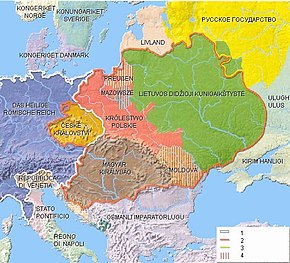Jagiellonian dynasty
The Jagiellons (also Jagellons) were a collateral line of the House of Gediminas, originating in the male line from Lithuania, and a European dynasty that provided the Polish kings and the Grand Princes of Lithuania from 1386 to 1572. They were also Hungarian, Croatian and Bohemian kings from the 15th century.
The founder of this dynasty was the Lithuanian Grand Duke Jogaila (Polish Jagiełło), who as Władysław II. Jagiełło in 1386 through marriage with the Polish Queen Hedwig of Anjou ascended the Polish throne in Krakow.
Jogaila was married four times, the last time since 1422 to Sofia from the Lithuanian-Ruthenian princely house of Holszański. With him she had two sons, Władysław III and Casimir IV. The Polish throne was inherited by Władysław, who, after being elected Hungarian king, fell in 1444 while saving Constantinople at the Battle of Varna with the Turks. Casimir (IV), Grand Duke of Lithuania since 1440, was appointed to the Polish throne as King Casimir II in 1447. His marriage to Elisabeth of Habsburg, daughter of the Roman-German King Albrecht II, produced thirteen children. He established marriage ties with many European dynasties.
Jagiellonian princes were also able to establish themselves as kings in Hungary, Croatia and Bohemia, first in competition, then (after the interlude of Matthias Corvinus) in collaboration with the Habsburgs. Vladislav II of Bohemia, Hungary and Croatia ruled three countries, as did his son Louis II. After the latter's unfortunate death in 1526 at the Battle of Mohács, he was succeeded by the Habsburg Ferdinand I and the magnate Johann Zápolya (brother-in-law of Sigismund I and Vladislav II, and uncle and regent of Louis II). Zapolya also married Sigismund's daughter Isabella in 1539 and bequeathed the Hungarian crown with the principality of Transylvania to both sons.
With Sigismund II. August, King of Poland and Grand Duke of Lithuania, the Jagiellonian dynasty died out in 1572, whereupon the hereditary kingship was replaced by an elective kingship in Poland and Lithuania. Both countries merged into the Rzeczpospolita, an aristocratic republic under the "presidency" of an elective king or elective grand prince at the head of state.
The Jagiellonians ruled the Kingdom of Poland, the Grand Duchy of Lithuania, the Kingdom of Bohemia, the Kingdom of Hungary and the Kingdom of Croatia around 1500 thanks to their diverse connections with the noble families of Europe. They strove to maintain a balance with the Roman-German Empire, the Ottoman Empire, and to consolidate their hold on the eastern flank on the territory of the former Kievan Rus against the Grand Duchy of Moscow. For this reason, in the Treaty of Vienna of 1515, Sigismund I ceded the crowns of Hungary, Croatia, and Bohemia to the descendants of Louis II's marriage union with the House of Habsburg. In Ostpolitik, the Jagiellons were able to maintain the balance of power in the face of the growing power of the Grand Duchy of Moscow. This conflict, into which the Kingdom of Poland also found itself drawn as a result of the Muscovite-Lithuanian Wars and the Union of Lublin of 1569, was resolved only after protracted wars under the reign of King Stephen Báthory. Jagiełło's descendants, who created the largest state in Central Europe during the 14th, 15th and 16th centuries, also laid the foundation of the Jagiellonian idea, which still lived on in the 20th century in the concept of 'Poland from sea to sea', that is, from the Baltic to the Black Sea.

The Cross of Lorraine, the dynastic coat of arms of the Jagiellonians

Largest sphere of influence of the Jagiellons in Europe since 1490 through the acquisition of the Hungarian crown until the Battle of Mohács in 1526, the beginning of the Turkish Wars in Central Europe, which lasted almost 200 years.
20th century
The followers of the Polish politician Józef Piłsudski, who after the restoration of Poland in 1918 sought the annexation of Lithuania and other territories lost to Russia before 1772 by recourse to history in the East, also called themselves "Jagiellons". This direction of the Polish interwar period was opposed by the supporters of Roman Dmowski, who justified territorial claims in the West by recourse to the former Polish dynasty of the Piast.
See also
- The Jagiellonian Family List
Search within the encyclopedia